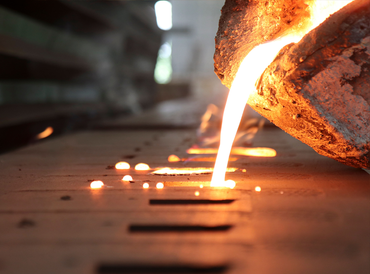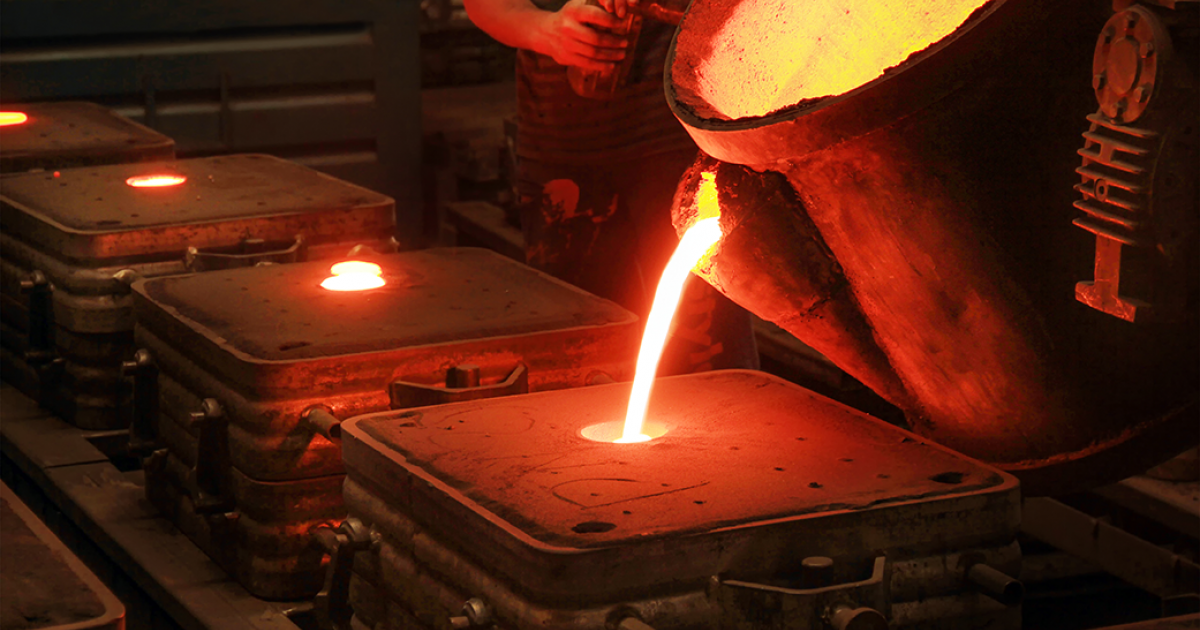Analyzing Metal Casting Applications Across Industries
Everything About Metal Casting: How Foundries Provide High Quality and Precision in Production
Metal casting stands as a fundamental procedure in production, where raw metals are transformed right into specific parts. Foundries use different casting approaches to attain desired features and forms. Each method features its very own set of advantages and restrictions. Recognizing these nuances is crucial for valuing just how top quality and precision are preserved throughout the procedure. The discussion in advance will discover the detailed characteristics of metal casting and its value across several markets.
The Essentials of Metal Casting
Metal casting is a basic process in producing that involves shaping molten metal right into desired forms. This necessary strategy begins with the selection of basic materials, typically various metal alloys, which are melted in a heating system. As soon as the metal gets to the appropriate temperature level, it becomes fluid and all set for casting.
The process needs a mold, usually made from sand, metal, or ceramic, which defines the final form of the cast things. As soon as the liquified metal is poured right into the mold and mildew, it strengthens and cools down, handling the mold and mildew's shapes.
After cooling, the casting is eliminated from the mold and mildew, and any type of needed finishing procedures, such as polishing or trimming, are carried out. This technique allows makers to create complicated shapes and elements with high precision and very little waste. Metal casting is commonly used across various sectors, from automotive to aerospace, emphasizing its significance in modern-day production.
Types of Casting Methods
While numerous casting approaches exist, each strategy uses one-of-a-kind advantages and is fit for various applications. Sand casting, one of one of the most typical methods, uses sand as the mold and mildew material, enabling for complex styles and large parts. Investment casting, recognized for its precision, utilizes a wax pattern coated in ceramic, making it suitable for intricate geometries. Die casting, which includes requiring liquified metal right into molds under high pressure, is regularly utilized for automation of tiny, comprehensive elements. Furthermore, covering molding incorporates sand and material to create thinner, extra accurate molds, boosting surface area coating. Another technique, continuous casting, allows the manufacturing of long sizes of metal forms, simplifying production processes. Each of these methods plays an essential role in the metal casting sector, attending to details needs from manufacturing volume to make complexity, consequently adding to the variety of applications across different industries.
The Role of Foundries in Production
Foundries serve a crucial feature in the manufacturing landscape, as they transform raw metals into useful elements through various casting procedures. These centers employ a variety of methods to develop items that satisfy exact specs, thus making certain top quality and effectiveness in manufacturing (Metal Foundry). By making use of approaches such as sand casting, financial investment casting, and die casting, factories accommodate varied sectors, including automobile, aerospace, and building and construction

Ultimately, factories are integral to the manufacturing ecosystem, supplying essential elements that sustain a broad array of applications and markets. Their precision and adaptability drive efficiency in contemporary manufacturing.
Materials Utilized in Metal Casting
The option of products utilized in metal casting is important for achieving the wanted properties and efficiency of the last item. Different steels such as bronze, iron, and aluminum are commonly used, each offering distinctive benefits. Light weight aluminum is preferred for its corrosion-resistant and lightweight top qualities, making it perfect for automobile and aerospace applications. Iron, particularly cast iron, is understood for its outstanding fluidity and toughness, appropriate for heavy equipment and framework parts. Bronze, with its remarkable wear resistance, is commonly used in aquatic atmospheres.
Additionally, materials such as silica sand are regularly utilized for mold and mildew making, supplying a great equilibrium in between longevity and ease of shaping. The selection of products likewise consists of ingredients like changes, which improve the casting process by improving fluidity and minimizing oxidation. Eventually, the suitable selection of these materials substantially affects the performance and quality of the casting process.
Quality assurance in the Casting Process
Quality control in the casting process is vital to guarantee that last items fulfill sector criteria and specifications. Various inspection techniques are used to determine flaws and evaluate the integrity of cast parts. In addition, adherence to established certifications and criteria improves the reliability and efficiency of actors materials.
Evaluation Techniques Employed
Keeping the honesty of actors metal parts depends greatly on numerous assessment methods. Foundries employ aesthetic examinations as an initial step to determine surface area issues, such as fractures or inclusions. Non-destructive testing (NDT) methods, consisting of ultrasonic testing and radiographic examination, are essential for spotting inner defects without compromising the element's integrity. Dimensional assessments utilizing calipers and coordinate measuring makers verify that parts satisfy specified resistances. Additionally, chemical evaluation confirms that the alloy make-up straightens with needed standards. These inspection strategies collectively confirm that the castings satisfy the required high quality and performance criteria, eventually lessening the threat of failing in their designated applications. Executing these extensive evaluations is fundamental for preserving high requirements in metal casting manufacturing.
Specifications and Certifications
Requirements and accreditations play a critical duty in the high quality control of the casting procedure. Foundries follow different international and industry-specific criteria, such as ISO 9001 and ASTM standards, ensuring uniformity and dependability in their items. These requirements describe the needed standards for products, production methods, and screening treatments, adding to a more effective manufacturing procedure. Certifications, such as AS9100 for aerospace applications, additionally stress the significance of quality control in specialized markets. By acquiring these qualifications, factories show their dedication to excellence, lowering issues and improving customer complete satisfaction. Routine audits and inspections confirm compliance, promoting continuous improvement and innovation within the industry. Inevitably, adherence to developed criteria grows trust between makers and customers.
Developments in Casting Technology

3D Printing Combination
Incorporating 3D printing innovation right into metal casting processes is changing the manufacturing landscape. This cutting-edge blend enhances the design and manufacturing of intricate geometries that typical approaches struggle to attain. By utilizing additive manufacturing for creating cores and molds, foundries can substantially minimize preparations and product waste. 3D printing permits for fast prototyping, making it possible for makers to examine layouts promptly and effectively, therefore promoting iterative renovations. This technology likewise supports the production of lightweight parts, which are vital in markets like aerospace and auto. Because of this, the combination of 3D printing not just simplifies procedures but additionally elevates the precision and high quality of actors metal products, noting a noteworthy development in the industry.
Automated Manufacturing Processes
The innovations in 3D printing have actually led the way for further technologies in automatic production procedures within metal casting. Foundries are progressively adopting robotics and automation to boost effectiveness and precision. Automated systems improve the whole casting process, from mold production to pouring and finishing. Smart sensors and real-time monitoring allow for specific control of temperature levels and product circulation, minimizing waste read more and improving top quality. Furthermore, software application solutions promote much better style and simulation, enabling producers to optimize processes before manufacturing starts. These automatic production processes not just lower labor prices however likewise decrease human mistake, guaranteeing constant output. Consequently, the integration of advanced modern technologies in metal casting is transforming production capacities and meeting the expanding needs of different industries.
Advanced Product Advancement
As markets require greater performance and sustainability, improvements in material growth for metal casting are becoming a vital focus. Engineers and researchers are exploring brand-new alloys and compounds that enhance mechanical residential or commercial properties while minimizing ecological effect. Technologies include light-weight products that keep strength, allowing far better fuel efficiency in transport applications. In addition, the consolidation of recycled materials is becoming a lot more prevalent, aligning with sustainability goals. Advanced casting methods, such as 3D printing and precision molding, allow for the production of complicated geometries that traditional methods can not accomplish. These developments not only improve the performance of cast components but additionally improve production efficiency. In general, the continual advancement of material science drives the future of metal casting, fulfilling the demands of contemporary markets.
Applications of Metal Casting Across Industries
Metal casting plays a crucial duty in numerous sectors, as it enables the production of intricate shapes and high-quality parts with relative performance - Aluminum Foundry. In the vehicle sector, cast metals are important for developing engine blocks, transmission instances, and various other necessary components that require toughness and precision. Aerospace sectors utilize metal casting for components like generator blades and structural elements, where dependability is critical
Furthermore, machinery and devices production gain from metal casting by producing equipments, real estates, and other detailed components that improve functionality. The building and construction industry also utilizes metal casting for building attributes, structural supports, and fittings, showcasing adaptability.
The medical field depends on cast metals for surgical instruments and implants, highlighting the demand for biocompatibility. Generally, metal casting is a foundational procedure across multiple markets, providing services that fulfill stringent quality criteria and efficiency requirements.
Often Asked Questions
What Safety Steps Are Taken in Metal Casting Foundries?
In metal casting factories, safety procedures include protective gear, ventilation systems, normal equipment maintenance, employee training, and emergency methods to mitigate threats related to high temperatures, dangerous materials, and potential accidents throughout the casting process.
Just How Do Foundries Handle Waste and Environmental Impact?
Foundries manage waste and ecological impact with recycling materials, executing filtration systems for exhausts, and adhering to regulations - Metal Foundry. They additionally embrace lasting techniques, such as minimizing power usage and making use of environmentally friendly materials in their procedures
What Are the Prices Related To Metal Casting Processes?
The costs linked with metal casting processes consist of resources, labor, equipment upkeep, power usage, and waste monitoring. Additionally, fluctuations in market value and compliance with ecological guidelines can considerably affect general expenditures for shops.
How Does Metal Casting Contrast to Various Other Production Methods?
Metal casting uses distinct benefits, such as complicated forms and high product effectiveness, compared to approaches like machining or marking. Nonetheless, it may involve much longer preparations and higher preliminary costs, relying on job specifications.
What Job Opportunities Exist in the Metal Casting Industry?
The metal casting market uses various profession possibilities, including factory management, procedure design, top quality guarantee, mold and mildew layout, and device procedure. Experts can likewise go after duties in r & d, sales, and environmental health and wellness.
Metal casting stands as a foundational procedure in manufacturing, where raw metals are changed right into details components. Metal casting is a fundamental procedure in manufacturing that entails forming molten metal into desired kinds. One more technique, continual casting, makes it possible for the production of long lengths of metal forms, streamlining manufacturing processes. The expenses associated with metal casting procedures consist of raw materials, labor, devices upkeep, power intake, and waste administration. The metal casting market offers numerous profession chances, consisting of shop management, process design, high quality guarantee, mold and mildew style, and machine procedure.